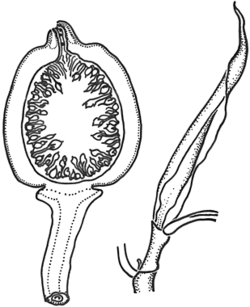
Description: Trees, shrubs or climbers, some epiphytic or strangling; latex usually milky, sometimes watery; bark on twigs and branches tough, not broken easily; dioecious or monoecious.
Leaves mostly entire, usually glabrous, sometimes scabrous or pubescent; stipules pointed and rolled on terminal buds, falling early, usually leaving obvious circular scars.
Inflorescences axillary, sometimes cauliflorous, flowers compact, the axis of the inflorescence invaginated forming a hollow, ± globose, fleshy receptacle (fig or syconium), with small bracts surrounding an apical orifice. Flowers very small. Perianth segments usually 1–5. Male flowers with 1 or 2 stamens. Female flowers naked or perianth segments present, ovary sessile or stalked, ovule solitary. Sterile flowers usually present, similar in structure to the female but the style shorter and thicker.
True fruits achenes, multiple fruit a syconium or fig.
Distribution and occurrence: World: c. 1000 species, chiefly India, Malesia to Polynesia. Australia: 42 species, all mainland States.
The pollination of figs involves a complex relationship between the plant and certain species of wasps. Ref. Galil (1977).
Text by G. J. Harden
Taxon concept:
Taxa not yet included in identification key
Ficus carica,
Ficus henneana
| | Key to the species | |
| 1 | Climber, neither epiphytic nor strangling, climbing by adventitious roots | Ficus pumila |
| Trees or shrubs, sometimes epiphytic or strangling | 2 |
| 2 | Leaves scabrous above; aerial roots absent; latex sparse, watery or slightly milky; fruit cauliflorous, ramiflorous or axillary | 3 |
| Leaves not scabrous above, glabrous or softly hairy; aerial roots present; latex usually copious, milky; fruit usually axillary, rarely ramiflorous or cauliflorous
Back to 1 | 4 |
| 3 | Figs densely hairy, lateral bracts on figs prominent, basal bracts falling early; lowest pair of secondary veins not extending up the lamina; base of lamina usually asymmetric | Ficus coronata |
| Figs scabrous but not distinctly hairy, lateral bracts absent, basal bracts 3, persistent; lowest pair of secondary veins extending midway up the lamina; base of lamina not asymmetric
Back to 2 | Ficus fraseri |
| 4 | Leaves with lower surface rusty-coloured and/or hairy, especially when young, upper surface green and mostly glabrous, rarely hairy | 5 |
| Leaves green and glabrous on both surfaces
Back to 2 | 6 |
| 5 | Petioles mostly less than 4 cm long; lamina mostly less than 10 cm long; stalk of fig 2–5 mm long | Ficus rubiginosa |
| Petioles more than 4 cm long; lamina generally more than 10 cm long; stalk of fig more than 10 mm long
Back to 4 | Ficus macrophylla |
| 6 | Figs more than 25 mm long, more or less ovoid and with a distinct apical nipple, stalk 1–2 cm long, thickened and expanded into a cupule | Ficus watkinsiana |
| Figs less than 25 mm long, more or less globose, mostly without a distinct apical nipple, stalk less than 10 mm long, neither prominently thickened nor expanded into a cupule
Back to 4 | 7 |
| 7 | Figs 20–25 mm diam., yellowish turning purple with paler spots at maturity, stalk 2–10 mm long; solitary in axils of leaves; petiole with a joint at apex | Ficus superba |
| Figs less than 20 mm diam.; white or pinkish brown or yellow turning orange or red at maturity, sessile or shortly stalked; mostly in pairs in axils of leaves; petiole without a joint at apex
Back to 6 | 8 |
| 8 | Stipules less than 1 cm long; figs white or pinkish brown, sessile; petiole more or less terete, more than a third as long as lamina | Ficus virens |
| Stipules more than 1 cm long; figs yellow turning red or orange at maturity, shortly stalked; petiole more or less flattened, less than a third as long as lamina
Back to 7 | 9 |
| 9 | Leaves mostly less than 8 cm long; petioles usually less than 18 mm long; figs mostly 6–10 mm diam., turning orange with dark spots, not warted | Ficus obliqua |
| Leaves mostly more than 8 cm long; petioles usually more than 18 mm long; figs commonly 10–20 mm diam., turning orange-red, often prominently warted
Back to 8 | Ficus rubiginosa |
|


